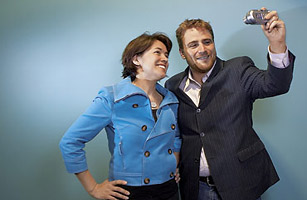
Tom Sawyer got it right. Why paint a fence when you can get your friends to do it for you for free? He would have been the perfect new-media mogul. Spending time and money creating content on the Internet is so hopelessly dated, so dotcom, so very, very 1.0. The secret of today's successful Web 2.0 companies: build a place that attracts people by encouraging them to create the content — thereby drawing even more people in to create even more stuff. The poster child of this Sawyeresque business model is the photo-sharing site called Flickr.
Caterina Fake, 37, an art director turned marketing whiz, and her Web designer husband Stewart Butterfield, 33, hatched the idea after an engineer at their fledgling online-gaming company devised a cool hack that let anyone share a photo on the Web fast and effortlessly. They set to work giving users other tools, including the ability to tag photos with keywords (the better to sort and find things) and write notes on them (the better to leave wry remarks for your pals). Flickr was born in February 2004, after three months of incubation. Then it grew like a sunflower at a pig farm. About 130 million photos have been posted by some 3 million registered users so far.
Falling hardware and broadband costs make Web 2.0 companies cheap to get off the ground. Fake and Butterfield started Flickr without a penny from venture capitalists, turning to family, friends and angel investors for seed money. That's a good thing. Flickr blossomed so fast into the de facto photo album of the Web that it attracted the attention of Yahoo, which bought it for, reportedly, nearly $30 million in March 2005. Not bad for a 16-month effort. IPOs? Web 1.0. Building it and flipping it to Yahoo, Google or Microsoft? Web 2.0. If only Mark Twain were alive.
Quittner is the editor of Business 2.0